一般疑问句,否定句改写
人教版小学英语年级句型转换练习
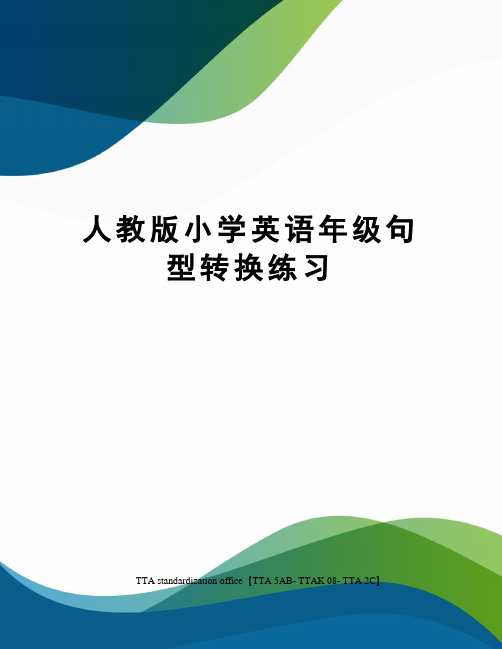
人教版小学英语年级句型转换练习TTA standardization office【TTA 5AB- TTAK 08- TTA 2C】一.一般型(四.五年级)1.This is a fan. (改为一般疑问句)2.That is the art room.(改为否定句)3.Is that the TV room (做否定回答)4.Is this the gym (做肯定回答)5. It’s time for English class. (变疑问句,并做肯定回答)6.It’s time for lunch. (改为用 It’s time to…表达的句子)is my hat. (变成一般疑问句,并做肯定回答)8.Is this your jacket(做否定回答,两种形式)colour is itIt’s red. (改为复数)________colour _______ ________ ________ _______red.10. This is my sweater.(改为复数)________ _________my _______.11. Those socks are new. (改为单数)________ ________ _________new.12. They are your pants.(变一般疑问句,并做肯定回答)13. The red skirt is Bett y’s .(改为同义句)14. What time is it (同义句)15. It’s time for music.(同义句)16. It’s warm today. (同义句)17. Where are they(变单数形式)18. This is Tommy’s shoe. (变复数形式)19. You can wear my new shirt.(变一般疑问句, 并做否定回答)20. This skirt is too small. (变复数形式)21. These are pencils. (变一般疑问句, 并做肯定回答)22. How much are these apples(变单数句子)23. I’ll take it.( 变复数句子)24. They are thirty-five yuan. (变一般疑问句, 并做肯定回答)25. This shirt is colourful.(变否定句)26. These are donkeys. (变一般疑问句, 并做肯定回答)27. They are sheep.(变成一般疑问句并做两种否定回答)28. Are those your T-shirts (作肯定回答)29. This is my dress.(改为复数形式)30. The pants aren’t long. (改为同义句)31. This room is the teacher’s.(改为复数句子)二.特殊疑问句:1.The library is on the first floor. (对划线部分提问)2.It’s nine o’clock.3.The picture is on the wall.4.It’s yellow.5. The sweater is on the bed.are socks and shoes.shirt is white.computer is on the desk.sweater is 90 yuan.10. The yellow shirt is 28 yuan.11. I can see five onions.12. I would like some tomatoes.句型转换(五年级)1.I go shopping on the weekend.2. I can see a box in front of the door.3. There are two old buses over there. (改单数形式)4. They climb mountains on Sundays.(改否定句)5.从方框中选择适当的词填空What Why Which Who Where Whenyou get up At 6:00.Zip’s favourite season?3. ________is your art teacher?4. _________season do you like best?5. __________are you from I’m from China.6. _________do you like winter Because I can skat.6. My birtheay is in June.7. There ________a lake and many trees near the house. (用be 填空)________________________________________________________________8. I like winter, because I can sleep a long time. (划线部分提问)________________________________________________________________9. Sometimes I visit my grandparents. (改为一般疑问句)________________________________________________________________are some pandas in the mountains.(改为否定句)________________________________________________________________11. Which season do you like best(写出同义句)__________________________________________________________________12. It is March 12th today.(划线部分提问)_____________________________________________________________________________ 13. Li Ping and I __________in Class One, Grade Five.(用be 填空)____________________________________________________________________________ 14. My favourite fruit is strawberries.(写出同义句)____________________________________________________________________________ 15. Why do you like winter (做出回答)______________________________________________________________________________ 16. I often wash the clothes.__________________________________________________________________(用now 改写)17. This is an apple.___________________________________________________________________(改复数形式)are in Class One.________________________________________________________________(改一般疑问句)19. Those are old buses.___________________________________________________________________(改单数形式)20. She is watching TV now._____________________________________________________________________(改否定句)21. I’m sweeping the floor. (提问)__________________________________________________________________________ 22. My mother is doing housework now. (变一般疑问句)___________________________________________________________________________grandma is answering the phone. (提问)___________________________________________________________________________ 24. I can make the bed. (提问)___________________________________________________________________________ 25. My mother is in the kitchen. (提问)___________________________________________________________________________句型转换(6年级上)(州编+海淀)Unit 1ually I walk to school. (改为同义句)2.We usually read books in our library (划线部分提问)3.I want to have eggs for lunch.(同上)4.They often write English after class.(改为进行时态)5.There’s a “s” in the word “school.6.(改错)7.8.I like spring best.(划线部分提问)9.I can go by the No. 1 bus. (变成一般疑问句)10.They go to school on foot.(划线部分提问)11.Do you know the traffic rules (做肯定回答及否定回答)12.Zoom goes to the restaurant by taxi.(变成否定句)Unit 213.The library is near the hospital. (划线部分提问)14.Go straight for five minutes. Then turn right. (对回答进行提问)___________ _________ __________get to the cinema?15.The cinema is near here.(变为一般疑问句,并做肯定回答)16.Thank you.(写出回答)17.I usually vistit my aunt (用tomorrow改写)Unit 318.I’m going to clean my room this afternoon. (改为为否定句)19.Are you going to the cinema this evening (做肯定回答)20.I’m going to the theme park tomorrow. (划线部分提问)21.I’m going to visit my aunt on Sunday. (划线部分提问)22.I go to the USA by plane. (划线部分提问)23.The shoe store is east of the cinema. (划线部分提问)24.I’m going to buy an English book in the bookstore. (划线部分提问)25.I’m going to the supermarket. (划线部分提问)26.I want to be a soldier. (划线部分提问)27.He’s going to fly kites next Sunday. (用now 改写)期中:22.The cinema is next to the hospital.(划线部分提问)23.There are three old bikes under the tree.(改为单数句子)24.My mother often visits my grandparents.(用tomorrow改写)25. His brother can swim.(用now改写)Unit 4:26. I like playing football. (划线部分提问)27. Does her uncle work in Sichuan (作肯定回答)28. Sarah goes to school on foot. (变为一般疑问句)29. Liu Yun likes playing the violin. (划线部分提问)30. I read newspapers every evening. (用人称he 改写句子)。
一般疑问句,否定句以及对划线部分提问的答题方法[1]
![一般疑问句,否定句以及对划线部分提问的答题方法[1]](https://img.taocdn.com/s3/m/4ead43cd9b89680203d8255b.png)
一般疑问句,否定句以及对划线部分提问的答题方法改为一般疑问句:1.先找am, is, are, was, were或can, would,放在最前面2.如果没有am, is, are, was, were或can, would,则看动词:(1)动词是过去式,句前加Did,动词变原形,其余照抄;(2)动词是第三人称单数,句前加Does,动词变原形,其余照抄。
(3)动词是原形,则句前加Do,其余照抄。
改为否定句:1.方法和上面一样,先找am, is, are, was, were或can, would,再后加not,其余照抄;2.如果没有am, is, are, was, were或can, would,则看动词:(1)动词为过去式,人后加didn’t,动词变原形,其余照抄;(2)动词为第三人称单数,人后加does n’t, 动词改为原形,其余照抄。
(3)动词为原形,则人后加don’t,其余照抄对划线部分提问:1.用适当的疑问词代替划线部分2.将剩余部分改为一般疑问句(注:如划线部分为主语,则用who代替,其余照抄;如划线部分为动词或动词短语,则用do代替,句前加what,再改为一般疑问句。
)学习小贴士:1.在be动词(is, am, are, was, were)或情态动词(can, may, must, should, would, could)后面加not,可以缩写成n’t. (情态动词后面动词用原形)如:I am a student. → I am not a student. (am not不能缩写)They are on the desk. → They are not on the desk.(are not = aren’t)2.在动词前加don’t, doesn’t, didn’t如:I have a pen.→ I don’t have a pen.She likes watching TV.→ She doesn’t like watch TV.(doesn’t后面用动词原形)We went to the park yesterday.→ We didn’t go to school yesterday. (didn’t 后面用动词原形) 3.祈使句的否定形式在句首在Don’t如: Open the door.→ Don’t open the door. (注意Don’t后面的单词开头字母不要大写)注:在改否定句时,如果句子中有some要改成any如:There are some birds in the tree.→ There aren’t any birds in the tree改一般问句和否定句要注意:☆ some 要变成 any如: There are some toys on the bed.→Are there any toys on the bed?☆第一人称(我)要与第二人称(你)互换如: I am at school now.→ Are you at school now? ( I 要变成you,所以be动词改成are)My father likes reading magazines.→ Does your father like reading magazines?对划线部分提问要注意:根据划线内容找出相对应的疑问词how和wh-词(what, when, where等),后面如有be动词或情态动词就跟be动词或情态动词,没有be动词或情态动词,后加do/does/did,划线部分的内容在问句中不出现。
改为一般疑问句和否定句
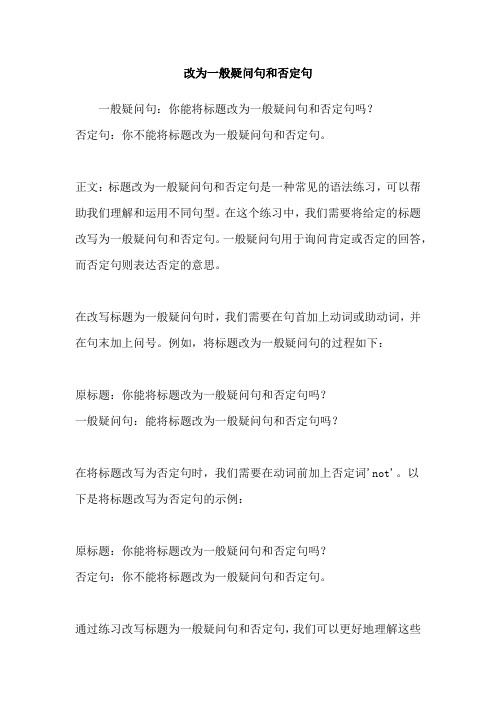
改为一般疑问句和否定句
一般疑问句:你能将标题改为一般疑问句和否定句吗?
否定句:你不能将标题改为一般疑问句和否定句。
正文:标题改为一般疑问句和否定句是一种常见的语法练习,可以帮助我们理解和运用不同句型。
在这个练习中,我们需要将给定的标题改写为一般疑问句和否定句。
一般疑问句用于询问肯定或否定的回答,而否定句则表达否定的意思。
在改写标题为一般疑问句时,我们需要在句首加上动词或助动词,并在句末加上问号。
例如,将标题改为一般疑问句的过程如下:
原标题:你能将标题改为一般疑问句和否定句吗?
一般疑问句:能将标题改为一般疑问句和否定句吗?
在将标题改写为否定句时,我们需要在动词前加上否定词'not'。
以
下是将标题改写为否定句的示例:
原标题:你能将标题改为一般疑问句和否定句吗?
否定句:你不能将标题改为一般疑问句和否定句。
通过练习改写标题为一般疑问句和否定句,我们可以更好地理解这些
句型的用法和结构。
这对于我们提高英语表达能力和进一步学习语法都非常有帮助。
句子改写-否定句和一般疑问句

句子改写——否定句、一般疑问句1. It is a big tiger.否定句____________________________一般疑问句2.We are sitting under the tree.否定句____________________________一般疑问句3.Mike and David are my cousins.否定句____________________________一般疑问句4.There is some milk in the glass.否定句____________________________一般疑问句5. There are some buses in the street.否定句____________________________一般疑问句6.I am having lunch in the kitchen.否定句____________________________一般疑问句7.We are playing the guitar on Sundays.否定句____________________________一般疑问句8.They are watching TV.否定句____________________________一般疑问句9.I can play the piano.否定句____________________________一般疑问句10.S he can make a nice cake.否定句____________________________一般疑问句11.They can go shopping on Saturdays.否定句____________________________一般疑问句12.I often play football after school.否定句____________________________一般疑问句13.They go to bed at 9:30.否定句____________________________一般疑问句14.I have a nice toy.否定句____________________________一般疑问句15.We like drawing.否定句____________________________一般疑问句16.I do my homework after school.否定句____________________________一般疑问句17.H e likes swimming.否定句____________________________一般疑问句18.S he likes listening to the radio.否定句____________________________一般疑问句19. Tom goes to school on Monday.否定句____________________________一般疑问句20. Sam does his homework every day.否定句____________________________一般疑问句21. My mum washes clothes every day. 否定句____________________________一般疑问句22. He usually has lunch at school.否定句____________________________一般疑问句23. I went to Shanghai last year.否定句____________________________一般疑问句24. We played soccer yesterday.否定句____________________________一般疑问句25. He saw a tall giraffe last Sunday.否定句____________________________一般疑问句26.H e gave me a lot of new books.否定句____________________________ 一般疑问句。
变一般疑问句练习题(附答案)
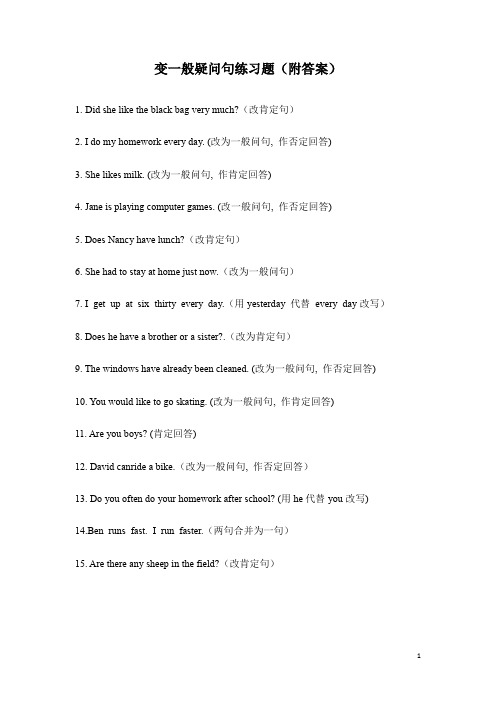
变一般疑问句练习题(附答案)1.Did she like the black bag very much?(改肯定句)2. I do my homework every day. (改为一般问句, 作否定回答)3. She likes milk. (改为一般问句, 作肯定回答)4. Jane is playing computer games. (改一般问句, 作否定回答)5. Does Nancy have lunch?(改肯定句)6. She had to stay at home just now.(改为一般问句)7. I get up at six thirty every day.(用yesterday代替every day改写)8. Does he have a brother or a sister?.(改为肯定句)9. The windows have already been cleaned. (改为一般问句, 作否定回答)10. You would like to go skating. (改为一般问句, 作肯定回答)11. Are you boys? (肯定回答)12. David canride a bike.(改为一般问句, 作否定回答)13. Do you often do your homework after school? (用he代替you改写)14.Ben runs fast.I run faster.(两句合并为一句)15. Are there any sheep in the field?(改肯定句)答案:1. She liked the black bag very much?2. Do you do your homework every day? No, I don’t3. Does she like milk? Yes, she does.4.Is Jane playing computer games? No, she isn’t.5. Nancy has lunch.6. Did she have to stay at home just now?7. I got up at six thirty yesterday.8. He has a brother and a sister.9. Have the windows have been cleaned yet? No, they haven’t10. Would they like to go skating? Yes, sure.(等)11. Yes, we are12. Can David ride a bike? No, he can’t.13. Does he often do his homework after school?14. Ben and I run fast.15. There are some sheep in the field.。
改一般疑问句的方法

改一般疑问句的方法
一般疑问句是一种句式,用来表达某种疑问或示意。
它们常常出现在电影或书中,因为它们可以帮助人们理解发生了什么。
下面就介绍一般疑问句改写的方法。
首先,读者需要明确原句的意思。
一般疑问句一般会涉及到某事是否发生,或者某人是否做某件事。
回答此类问题的方式通常是使用反意疑问句,如:“Did it happen?”成:Did it not happen?
其次,读者可以通过把原句变成一般句来改写一般疑问句。
例如,从“Did you do it?”成:You did it.”
第三,读者可以把一般疑问句变成特殊疑问句来改写。
特殊疑问句除了问句本身外,还涉及到另外一个部分,即答案。
比如,从“Are you going?”成“Where are you going?”
最后,读者可以把一般疑问句变成否定句来改写。
否定句一般会涉及到“not”或“never”等词,如从“Do you like it?”成:You don like it.”
总之,一般疑问句可以改写为反意疑问句、一般句、特殊疑问句和否定句这几种句式。
它们可以让读者更容易理解句子的意思,也能让文章显得更加活泼生动。
当然,读者应该根据文章的需要来选择最合适的句式,以便把精彩的故事讲给读者。
- 1 -。
(完整版)小学英语一般疑问句、否定句和特殊疑问(附习题)(可编辑修改word版)
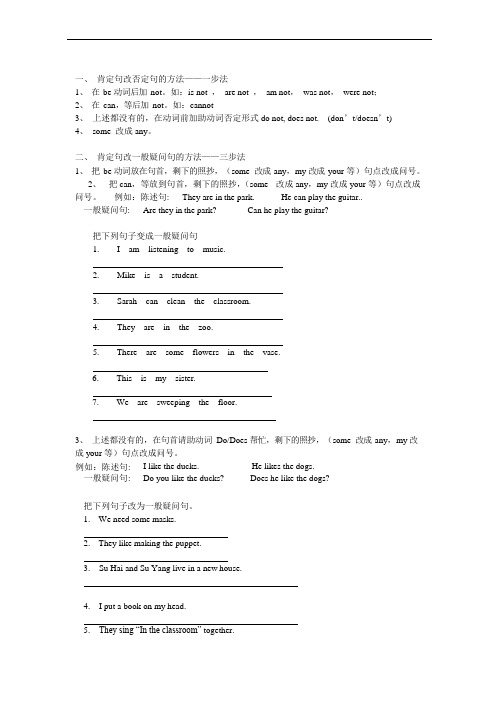
一、肯定句改否定句的方法——一步法1、在be 动词后加not。
如:is not ,are not ,am not,was not,were not;2、在can,等后加not。
如:cannot3、上述都没有的,在动词前加助动词否定形式do not, does not. (don’t/doesn’t)4、some 改成any。
二、肯定句改一般疑问句的方法——三步法1、把be 动词放在句首,剩下的照抄,(some 改成any,my 改成your 等)句点改成问号。
2、把can,等放到句首,剩下的照抄,(some 改成any,my 改成your 等)句点改成问号。
例如:陈述句: They are in the park. He can play the guitar..一般疑问句: Are they in the park? Can he play the guitar?把下列句子变成一般疑问句1. I am listening to music.2. Mike is a student.3. Sarah can clean the classroom.4. They are in the zoo.5. There are some flowers in the vase.6.This is my sister.7.We are sweeping the floor.3、上述都没有的,在句首请助动词Do/Does 帮忙,剩下的照抄,(some 改成any,my 改成your 等)句点改成问号。
例如:陈述句: I like the ducks. He likes the dogs.一般疑问句: Do you like the ducks? Does he like the dogs?把下列句子改为一般疑问句。
1.We need some masks.2.They like making the puppet.3.Su Hai and Su Yang live in a new house.4.I put a book on my head.5.They sing “In the classroom” together.6.We play basketball on Sundays.7.Tom likes listening to music三、肯定句改特殊疑问句的方法——四步法1、在一般疑问句的基础上,句首添加一个疑问词即可,可根据划线部分确定是什么疑问词。
英语语法题:改写否定句和一般疑问句
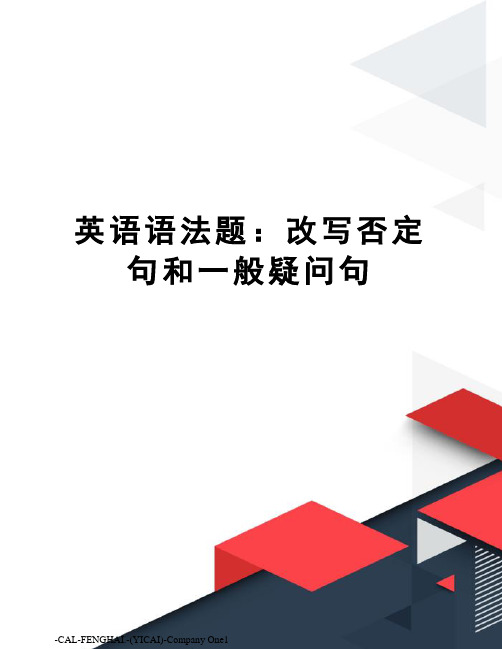
英语语法题:改写否定句和一般疑问句1.It is a big tiger.否定句____________________________一般疑问句2.We are sitting under the tree.否定句____________________________一般疑问句3.Mike and David are my cousins.否定句____________________________一般疑问句4.There is some milk in the glass.否定句____________________________一般疑问句5. There are some buses in the street.否定句____________________________一般疑问句6.I am having lunch in the kitchen.否定句____________________________一般疑问句7.We are playing the guitar on Sundays.否定句____________________________一般疑问句8.They are watching TV.否定句____________________________一般疑问句9.I can play the piano.否定句____________________________一般疑问句10.S he can make a nice cake.否定句____________________________一般疑问句11.They can go shopping on Saturdays.否定句____________________________一般疑问句12.I often play football after school.否定句____________________________一般疑问句13.They go to bed at 9:30.否定句____________________________ 一般疑问句14.I have a nice toy.否定句____________________________ 一般疑问句15.We like drawing.否定句____________________________ 一般疑问句16.I do my homework after school.否定句____________________________ 一般疑问句17.H e likes swimming.否定句____________________________ 一般疑问句18.S he likes listening to the radio.否定句____________________________ 一般疑问句19. Tom goes to school on Monday.否定句____________________________ 一般疑问句20. Sam does his homework every day.否定句____________________________ 一般疑问句21. My mum washes clothes every day.否定句____________________________ 一般疑问句22. He usually has lunch at school.否定句____________________________ 一般疑问句23. I went to Shanghai last year.否定句____________________________ 一般疑问句24. We played soccer yesterday.否定句____________________________ 一般疑问句25. He saw a tall giraffe last Sunday.否定句____________________________ 一般疑问句26.H e gave me a lot of new books.否定句____________________________ 一般疑问句。
否定句、疑问句总结

句型转换:一般疑问句、否定句的变化规律要点精析一、陈述句该为一般疑问句或是否定句的变化规律1.当句中有be动词(am,is are)时,改成否定句时,在be动词后加not;改成一般疑问句时,把2.I would like to have some milk. (改成一般疑问句) ——————————————————————————3.They often go to the library on the weekend.( 改成一般疑问句) ——————————————————————————4.My friend go to school on foot. (改为否定句)——————————————————————————5.I am going to do my homework tomorrow.( 改成一般疑问句) ——————————————————————————6.Please read Lesson One.(改为否定句)_________ __________ Lesson One,please.7.Jackie has lunch at schoo1.(改为一般疑问句)_________ Jackie __________ lunch at school ?8. They go to bed early.(改为一般疑问句)________ they ________ to bed early?9. Mike does well in English. (改为否定句)Mike _______ _______ well in English.10.u Hai and Su Yang look the same.(改为一般疑问句)_______ Su Hai and Su Yang _______ the same?11. They studied at Guangzhou International school.(改为一般疑问句) _______ they _______ at Guangzhou International school?12. There is some water in the bottle.(改为一般疑问句)_______ there _______ water in the bottle?2.用情态动词的情况下有特殊情况。
六年级下册英语改写句子专项练习
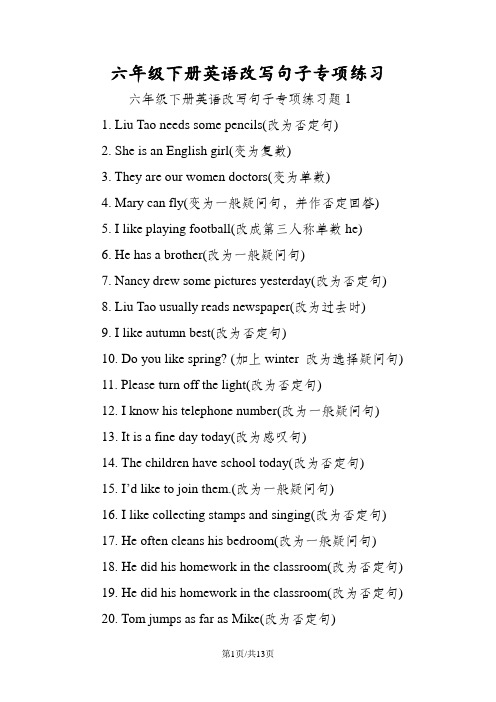
六年级下册英语改写句子专项练习六年级下册英语改写句子专项练习题11. Liu Tao needs some pencils(改为否定句)2. She is an English girl(变为复数)3. They are our women doctors(变为单数)4. Mary can fly(变为一般疑问句,并作否定回答)5. I like playing football(改成第三人称单数he)6. He has a brother(改为一般疑问句)7. Nancy drew some pictures yesterday(改为否定句)8. Liu Tao usually reads newspaper(改为过去时)9. I like autumn best(改为否定句)10. Do you like spring? (加上winter 改为选择疑问句)11. Please turn off the light(改为否定句)12. I know his telephone number(改为一般疑问句)13. It is a fine day today(改为感叹句)14. The children have school today(改为否定句)15. I’d like to join them.(改为一般疑问句)16. I like collecting stamps and singing(改为否定句)17. He often cleans his bedroom(改为一般疑问句)18. He did his homework in the classroom(改为否定句)19. He did his homework in the classroom(改为否定句)20. Tom jumps as far as Mike(改为否定句)21. I see a man behind me(改为一般过去时)22. Helen is good at singing(同义句)23. The boy can jump higher than the girl(改为否定句)24. Tom jumps as far as Mike(改为否定句)25. I see a man behind me(改为一般过去时)26. Helen is good at singing(同义句)27. The boy can jump higher than the girl(改为否定句)28. Liu Tao needs some pencils(改为否定句)29. She is an English girl(变为复数)30. They are our women doctors(变为单数)31. Mary can fly(变为一般疑问句,并作否定回答)32. I like playing football(改成第三人称单数he)33. He has a brother(改为一般疑问句)34. Nancy drew some pictures yesterday(改为否定句)35. Liu Tao usually reads newspaper(改为过去时)36. The computer is very nice(改为感叹句)37. Are they American cars? (改为单数)38. Don’t go along this street(改为肯定句)39. The policeman caught the thief(改问正在进行时)40. It always rains in summer there(改为一般疑问句,作肯定回答)41. Turn right at the third crossing(改为否定句)42. How can I get to the shopping centre? (改为同义句)43. He does well in Maths(改为否定句)44. Mike runs as fast as Ben(改为一般疑问句)45. I get up at six thirty every day(用yesterday morning 替代every day)46. Ben runs fastI run faster(两句合并为一句)47. The policeman caught the thief(改为一般疑问句,作否定回答)48. I like autumn best(改为否定句)49. Do you like spring? (加上winter 改为选择疑问句)50. Please turn off the light(改为否定句)51. I know his telephone number(改为一般疑问句)52. It is a fine day today(改为感叹句)53. The children have school today(改为否定句)54. I’d like to join them.(改为一般疑问句)55. I like collecting stamps and singing(改为否定句)56. He often cleans his bedroom(改为一般疑问句)六年级下册英语改写句子专项练习题21. She does housework at the weekends. (改为否定句)2. Mike runs as fast as Ben. (改为一般疑问句)3. I get up at six thirty every day. (用yesterday afternoon替代every day)4. Nancy is good at English and Maths. (对画线部分提问)5. Mike runs fast. I run faster. (两句合并为一句)6. The policeman caught the thief. (改为一般疑问句,作否定回答)7. My sister is thirty kilos. (对画线部分提问)8. Turn right at the third crossing. (改为否定句)9. How can I get to the supermarket? (改为同义句)10. The camera is very nice. (改为感叹句)11. Are they American cars? (改为单数)12. Go along this street. (改为否定句)13. Give the purse to me. (换一种说法,句意不变)14. The policeman caught the thief. (改问正在进行时)15. I get to the shopping centre by bus. (对画线部分提问)16. It always rains in summer there. (改为一般疑问句,作肯定回答)17. It’s cold in winter there. (对画线部分提问)18. I like autumn best. (改为否定句)19. Do you like spring? (加上winter 改为选择疑问句)20. Su Yang is asking Ben some questions. (对画线部分提问)21. Please turn off the light. (改为否定句)22. I know his telephone number. (改为一般疑问句)23. It is a fine day today. (改为感叹句)24. The children have school today. (改为否定句)25. I’d like to join them.(改为一般疑问句)26. They are going to see a film tomorrow. (对画线部分提问)27. I like collecting stamps and singing. (改为否定句)28. He often cleans his bedroom. (改为一般疑问句)29. My mother is watering flowers in the garden. (对画线部分提问)30. David and Mike are going to planting trees this afternoon.(对画线部分提问)31. He did his homework in the classroom. (改为否定句)32. Wang Bing is heavier than Gao Shan. (对画线部分提问)33. Tom jumps as far as Mike. (改为否定句)34. I see a man behind me. (改为一般过去时)35. Helen is good at singing. (同义句)36. The boy can jump higher than the girl. (改为否定句)37. It is hot in summer in New York. (对画线部分提问)38. Liu Tao needs some pencils. (改为否定句)39. She is an English girl. (变为复数)40. They are our women doctors. (变为单数)41. Mary can fly. (变为一般疑问句,并作否定回答)42. I like playing volleyball. (改成第三人称单数he)43. She has a brother. (改为一般疑问句)44. Liu Tao drew some pictures yesterday. (改为否定句)45. Nancy usually reads magazines. (改为过去时)46. I am a stedent .(改为一般疑问句)六年级下册英语改写句子专项练习题31. He does well in Maths. (改为否定句)2. Mike runs as fast as Ben. (改为一般疑问句)3. I get up at six thirty every day. (用yesterday morning 替代every day)4. Jim is good at English and Maths. (对画线部分提问)5. Ben runs fast. I run faster. (两句合并为一句)6. The policeman caught the thief. (改为一般疑问句,作否定回答)7. He is thirty kilos. (对画线部分提问)8. Turn right at the third crossing. (改为否定句)9. How can I get to the shopping centre? (改为同义句)10. The computer is very nice. (改为感叹句)11. Are they American cars? (改为单数)12. Don’t go along this street. (改为肯定句)13. Give the purse to me. (换一种说法,句意不变)14. The policeman caught the thief. (改问正在进行时)15. I get to the shopping centre by bus. (对画线部分提问)16. It always rains in summer there. (改为一般疑问句,作肯定回答)17. It’s cold in winter there. (对画线部分提问)18. I like autumn best. (改为否定句)19. Do you like spring? (加上winter 改为选择疑问句)20. Su Yang is asking Ben some questions. (对画线部分提问)21. Please turn off the light. (改为否定句)22. I know his telephone number. (改为一般疑问句)23. It is a fine day today. (改为感叹句)24. The children have school today. (改为否定句)25. I’d like to join them.(改为一般疑问句)26. They are going to see a film tomorrow. (对画线部分提问)27. I like collecting stamps and singing. (改为否定句)28. He often cleans his bedroom. (改为一般疑问句)29. Liu Tao is watering flowers in the garden. (对画线部分提问)30. David and Mike are going to planting trees this afternoon. (对画线部分提问)31. He did his homework in the classroom. (改为否定句)32. Wang Bing is heavier than Gao Shan. (对画线部分提问)33. Tom jumps as far as Mike. (改为否定句)34. I see a man behind me. (改为一般过去时)35. Helen is good at singing. (同义句)36. The boy can jump higher than the girl. (改为否定句)37. It is hot in summer in New York. (对画线部分提问)38. Liu Tao needs some pencils. (改为否定句)39. She is an English girl. (变为复数)40. They are our women doctors. (变为单数)41. Mary can fly. (变为一般疑问句,并作否定回答)42. I like playing football. (改成第三人称单数he)43. He has a brother. (改为一般疑问句)44. Nancy drew some pictures yesterday. (改为否定句)45. Liu Tao usually reads newspaper. (改为过去时)六年级英语下册总复习专项训练——适当词填空1. Gao Shan’s uncle is ( short) than his father.2. The horse is as ( thin) as the goat .3. Who’s taller than ( she).4. That isn’t my coat. (My) is over there.5. I want to (visit) him one day.6. Mr Elephant’s tail is (long) than Mr Monkey’s.7. Let me (show) you how (do) it.8. You can (play) the computer games.9. Why don’t you (make) a puppet?10. Look! The children (have) an English lesson.11. What’s your (high)?12. The red skirt is (small) than the bule one.13. We (have) a birthday party yesterday.14. Can you pick (them) up for me?15. It’s Children’s Day. All the students are very (excite).16.Ben an Benny are good at (China).17. She wants (buy) a new pen.18. It often (rain) in summer.19. Sometimes they (not have) lunch at home.20. Look! The bus (come).21. He (make) many cakes for his friends yesterday.22. (be) there any tea in the cup?23. Miss Li (teach) you English next term.24. My brother (see) his classmate’s photo in the newspaper yesterday.25. He (like) making a snowman in winter.26. She (go) to the cinema with her classmates tomorrowevening.27. Sam and I (be) in different classes. There (be) one hundred students in our classes.28. ----Look! What they (do) now?----They (pick) the apples.29. What would you like (eat)? I want to eat some cakes.30. ----What (do) Su Hai do on last Sunday morning?----She (go) for a walk in the park.31. ---- (do) you go swimming last Saturday?----No. We (watch) a film.32. ----What (do) Wang Bing usually do after school?----He usually (go) home and (draw) some pictures.33. ----Is Miss Li in the teacher’s office now?----No. She’s (take) photos in the garden.34. It’s ( rainy / raining) in spring in New York.35. Summer in New York is as (hot / hotter) as Nanjing.36. Su Yang wants to know about (weather / the weather) in Shanghai.37. (There is / There are) a lot of rain in spring in the city.38. Which season (are / do) you like best?39. Ben (want) a penfriend in China.40. Miss Li (like) (draw) horses.41. My hobbies are (swim) and (dance).42. I (read) newspapers last night.43. I am (do ) my homework now.44. David is (show) his photos to his classmates.45. I (have) a birthday party last week. My penfriend (come) to my party,and I was very happy.46. ----Do you like (yellow flower)?----No,I don’t.47. ---- (there be) any shops near your school?----Yes.48. ----Do you like (row)?----Yes,I do.49. ----What are you going to do?----I’m going to (have a picnic).50. Last Friday,I (take part in) a sports meeting.51. ----What (do) he like?----He (like) playing table tennis.52. Miss Yang is as (old) as Miss Wang,but she looks (young) than Miss Wang.53. My sister (go) to the supermarket every Sunday.54. We (do not) watch TV last night.55. My mother (look) (young) than my aunt.56. ----Is Gao Shan in the bedroom?----No,he (is) there a moment ago. Now he’s (water) the flowers in the garden.57. Let’s go (camp) on Sunday.58. I’m the only (children) in my family.59. Yesterday I (meet) my friend Jack in the street. We (be) very glad to see each other.60. He asked me how (get) to the shopping center.61. Turn left at the first (cross).62. You can take bus No.6 and get off at the (two) stop.63. (that) are apples.64. To get there (fast),you can take bus No.7.65. Would you like (go) shopping with (I)?66. There are (twelve) months in a year. December is the (twelve) month of a year.67. How many (season) are there in a year?68. Is there (some) tea in the bottle?69. Liu Tao is reading a story (in /on) the newspaper.70. David wants (draw) a picture.71. Listen! The girl (read) in her bedroom.72. He usually (come) to school at 7:30 in the morning.73. What day (be) it yesterday?74. (be) there any water in the glass?75. Are you good at (fish)?76. We saw (he) playing football on the playground.77. Who would like (read) the new words for us?78. Look! The children (swim) in the lake.79. The girls (watch) a football match next Sunday.80. Don’t talk! We (have) a Maths lesson.。
译林版三上英语句型转换,很多孩子容易失分的地方,特意整理出来

三年级句型转换班级__________ 姓名______________一:仿照例子写句子:例:陈述句:She is a girl. 例:陈述句:She can run.否定句:She is not (=isn’t)a girl. 否定句:She cannot(=can’t )run.一般疑问句:Is she a girl?一般疑问句:Can she run?肯定回答:Yes,she is. 肯定回答:Yes,She can.否定回答:No,she isn’t. 否定回答:No ,she can’t1、She is my sister.2、He can dance.否定句:否定句:一般疑问句:一般疑问句:肯定回答:肯定回答:否定回答:否定回答:3、She is tall. 4.He can play football.否定句:否定句:一般疑问句:一般疑问句:肯定回答:肯定回答:否定回答:否定回答:例:陈述句:I am tall. 例子:陈述句:You are thin.否定句:I am not tall. 否定句You aren’t(=are not)thin.一般疑问句:Are you tall?一般疑问句:Are you thin?肯定回答:Yes ,I am. 肯定回答:Yes ,I am.否定回答:No,I am not . 否定回答:No,I am not1、I am a student.2、You are a teacher.否定句:否定句:一般疑问句:一般疑问句:肯定回答:肯定回答:否定回答:否定回答:3、I am fat.4、You are short.否定句:否定句:一般疑问句:一般疑问句:肯定回答:肯定回答:否定回答:否定回答:例:We are good friends. 例:They are tall.否定句:We aren’t (=are not)good friends. 否定句:They aren’t tall.一般疑问句:Are you good friends?一般疑问句:Are they tall.肯定回答:Yes,we are. 肯定回答:Yes,they are.否定回答:No,we aren’t. 否定回答:No ,they aren’t.1、We are thin.2、They are fat.否定句:否定句:一般疑问句:一般疑问句:肯定回答:肯定回答:否定回答:否定回答:二:根据例句改写句子。
英语改写句子大全
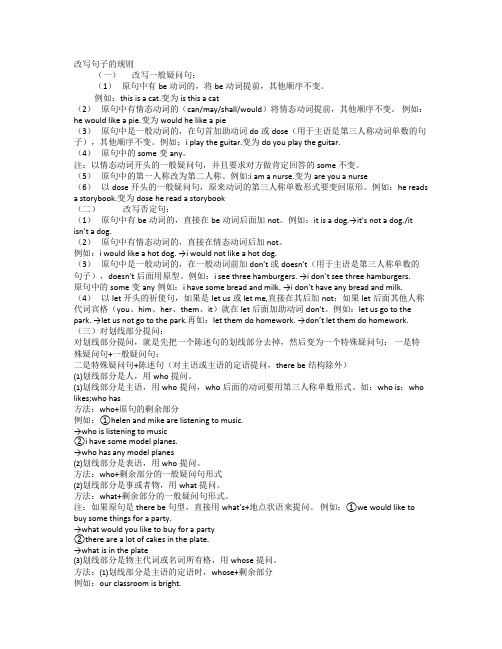
改写句子的规则(一)改写一般疑问句:(1)原句中有be动词的,将be动词提前,其他顺序不变。
例如:this is a cat.变为is this a cat(2)原句中有情态动词的(can/may/shall/would)将情态动词提前,其他顺序不变。
例如:he would like a pie.变为would he like a pie(3)原句中是一般动词的,在句首加助动词do或dose(用于主语是第三人称动词单数的句子),其他顺序不变。
例如:i play the guitar.变为do you play the guitar.(4)原句中的some变any。
注:以情态动词开头的一般疑问句,并且要求对方做肯定回答的some不变。
(5)原句中的第一人称改为第二人称。
例如:i am a nurse.变为are you a nurse(6)以dose开头的一般疑问句,原来动词的第三人称单数形式要变回原形。
例如:he reads a storybook.变为dose he read a storybook(二)改写否定句:(1)原句中有be动词的,直接在be动词后面加not。
例如:it is a dog.→it’s not a dog./it isn’t a dog.(2)原句中有情态动词的,直接在情态动词后加not。
例如:i would like a hot dog. →i would not like a hot dog.(3)原句中是一般动词的,在一般动词前加don’t或doesn’t(用于主语是第三人称单数的句子),doesn’t后面用原型。
例如:i see three hamburger s. →i don’t see three hamburgers.原句中的some变any例如:i have some bread and milk. →i don’t have any bread and milk.(4)以let开头的祈使句,如果是let us或let me,直接在其后加not;如果let后面其他人称代词宾格(you、him、her、them、it)就在let后面加助动词don’t。
沪教版五年级英语上册句型转换完美
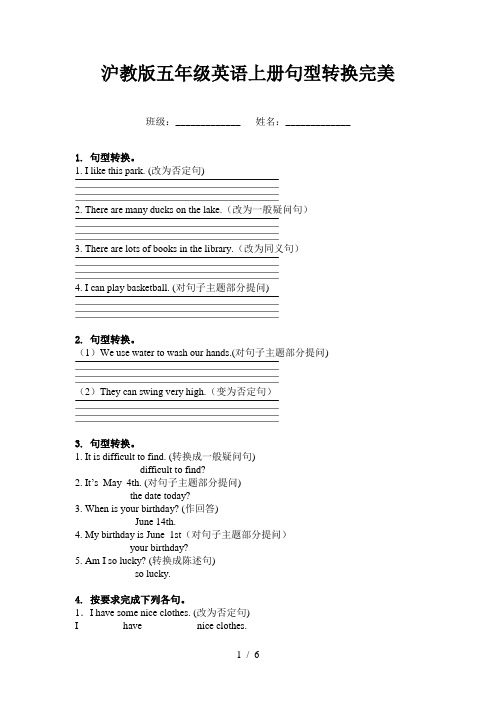
沪教版五年级英语上册句型转换完美班级:_____________ 姓名:_____________1. 句型转换。
1. I like this park. (改为否定句)2. There are many ducks on the lake.(改为一般疑问句)3. There are lots of books in the library.(改为同义句)4. I can play basketball. (对句子主题部分提问)2. 句型转换。
(1)We use water to wash our hands.(对句子主题部分提问)(2)They can swing very high.(变为否定句)3. 句型转换。
1. It is difficult to find. (转换成一般疑问句)______ ______ difficult to find?2. It’s May 4th. (对句子主题部分提问)_____ _____ the date today?3. When is your birthday? (作回答)______ _____ June 14th.4. My birthday is June 1st(对句子主题部分提问)_____ _____ your birthday?5. Am I so lucky? (转换成陈述句)_____ ______ so lucky.4. 按要求完成下列各句。
1.I have some nice clothes. (改为否定句)I ________ have __________ nice clothes.2.She tries on the new clothes.(改为一般疑问句)_______ she ________ on new clothes ?3.Because I can’t go to the party.(对句子主题部分提问)_______ can’t________ go to the party?4. My father comes back before 10 o’clock.(对句子主题部分提问) _______ does your father________ back?5.you , me, help , can , come , and (?) (连词成句)5. 句型转换。
一般疑问句的改写方法

一般疑问句的改写方法
1.使用助动词:把句子中的动词放在主语之前并加上适当的助动词。
例如:
原句:They are going to the party.
改写:Are they going to the party?
2.使用倒装结构:把助动词放在主语之前并把原来的主语移到助动词之后。
例如:
原句:She can speak French.
改写:Can she speak French?
3. 使用do/does/did:把动词原形改为do/does/did,并把原来的主语移到do/does/did之后。
例如:
原句:He plays soccer.
改写:Does he play soccer?
4.使用否定词:把肯定句改为否定句,并把原来的主语移到否定词之后。
例如:
原句:You have seen that movie.
改写:Haven't you seen that movie?
这些方法可以根据具体的句子结构和时态来选择合适的改写方式。
一般疑问句的改写方法可以帮助我们更灵活地表达问题或修改陈述句为疑问句。
句型转换
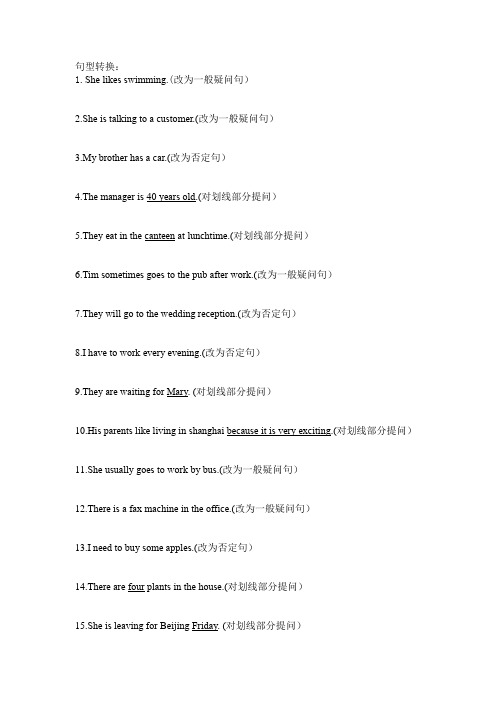
句型转换:1.She likes swimming.(改为一般疑问句)2.She is talking to a customer.(改为一般疑问句)3.My brother has a car.(改为否定句)4.The manager is 40 years old.(对划线部分提问)5.They eat in the canteen at lunchtime.(对划线部分提问)6.Tim sometimes goes to the pub after work.(改为一般疑问句)7.They will go to the wedding reception.(改为否定句)8.I have to work every evening.(改为否定句)9.They are waiting for Mary. (对划线部分提问)10.His parents like living in shanghai because it is very exciting.(对划线部分提问)11.She usually goes to work by bus.(改为一般疑问句)12.There is a fax machine in the office.(改为一般疑问句)13.I need to buy some apples.(改为否定句)14.There are four plants in the house.(对划线部分提问)15.She is leaving for Beijing Friday. (对划线部分提问)句型转换——改为一般疑问句专练1. They will go to Beijing for the holiday this summer. (改为一般疑问句) ________________________________2. It is time to go to school. (改为一般疑问句)________________________________3. I usually do my homework at eight. (改为一般疑问句)__________________________________________________4. She watched a football match yesterday. (改为一般疑问句)__________________________________________________5. I’d like to go swimming. (改为一般疑问句)________________________________6. They are playing football on the playground. (改为一般疑问句)________________________________7. There are seven days in a week. (改为一般疑问句)________________________________8. We had PE class on Tuesday last term. (改为一般疑问句)________________________________9. Jimmy likes playing computer games. (改为一般疑问句)___________________________________________________10. We go to school very early in the morning. (改为一般疑问句)_____________________________________11. He speaks English very well. (改为一般疑问句)_____________________________________12. I will make a present for my mother. (改为一般疑问句)_____________________________________13. We can help you clean the windows. (改为一般疑问句)______________________________________14. The woman in the car is my mother. (改为一般疑问句)______________________________________15. Linda likes apple pies for her lunch. (改为一般疑问句)______________________________________16. My mother worked in a hospital last year. (改为一般疑问句)______________________________________17. My parents can sing English songs very well. (改为一般疑问句)______________________________________18. English is my favorite subject. (改为一般疑问句)______________________________________19. She comes from America.(改为一般疑问句)______________________________________20. I am interested in singing. (改为一般疑问句)______________________________________句型转换集合1.The movie is very exciting.(改为感叹句)_________ ________ exciting movie !2.There is some milk in the bottle.(改为一般疑问句)_________ there ________ milk in the bottle?3.We had a good time last night. (保持句意基本不变)We ________ ________ last night.4.The girl eats little to make herself slim.(对划线部分提问)_________ _________ the girl eat little ?5. Tony has ten story books. Jimmy has five story books. (保持句意基本不变)Tony has ________ books _______ Jimmy.6.He did his homework last night. (改为否定句)He __________ __________ his homework last night.7.The kid is playing the piano at the school music club. (对划线部分提问)__________ is the kid __________ the piano?8.Visitors love this city because it has historical sights and delicious food. (改为同义句)Visitors love this city __________ _________ its historical sights and delicious food.9.他两个月没有收到他儿子的信了。
四年级英语湘少版上学期句型转换必考题

四年级英语湘少版上学期句型转换必考题班级:_____________ 姓名:_____________1. 按要求改写句子。
1. These are my friends.(改为单数句)2. This is my little sister.(改为一般疑问句,并作肯定回答)3. She is a clever pupil.(改为否定句)4. Are you fat?(作否定回答)5. It is a very naughty bird.(改为一般疑问句,并作否定回答)2. 按要求改写句子。
[1]We can see a boat on the river.(对句子主题意思提问)______ ______ you see on the river?[2]Mike can swim.(对句子主题意思提问)______ can Mike ______?[3]I can see some birds in the tree.(改为一般疑问句)______ you ______ ______ birds in the tree?[4]She can make a cake.(改为否定句)She ______ ______ a cake.[5]I can make a fruit salad.(对句子主题意思提问)______ can you ______?3. 按要求完成下列各题。
1.They are monkeys. (就句子主题意思提问)2.These are vegetables. (变为一般疑问句)3.It''s a potato. (变为复数句子)4.Is this the dining room? (作否定回答)5.It is next to the bookstore. (变为一般疑问句)4. 句型转换。
[1]I''m in New York.(改为一般疑问句)[2]I am in Beijing.(就句子主题意思提问)[3]Shall we go to the playground.(改为let型的祈使句)________ ________to the playground.[4]It''s 3 o''clock.(就句子主题意思提问)[5]Is it 8 o''clock?(做否定回答)________, it________.5. 按要求做题。
北师大版六年级英语上册句型转换竞赛练习
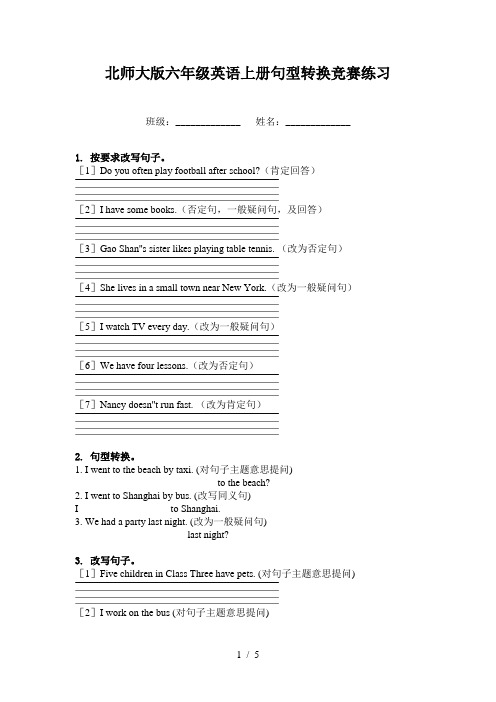
北师大版六年级英语上册句型转换竞赛练习班级:_____________ 姓名:_____________1. 按要求改写句子。
[1]Do you often play football after school?(肯定回答)[2]I have some books.(否定句,一般疑问句,及回答)[3]Gao Shan''s sister likes playing table tennis. (改为否定句)[4]She lives in a small town near New York.(改为一般疑问句)[5]I watch TV every day.(改为一般疑问句)[6]We have four lessons.(改为否定句)[7]Nancy doesn''t run fast. (改为肯定句)2. 句型转换。
1. I went to the beach by taxi. (对句子主题意思提问)____________________________ to the beach?2. I went to Shanghai by bus. (改写同义句)I __________________to Shanghai.3. We had a party last night. (改为一般疑问句)______________________ last night?3. 改写句子。
[1]Five children in Class Three have pets. (对句子主题意思提问)[2]I work on the bus (对句子主题意思提问)[3]It''s fun to light a candle at night. (改为感叹句)[4]What''s his age(年龄)?(同义句)________ ________ is he?[5]I used to be in trouble inclass . 我过去经常在课堂上惹麻烦。
- 1、下载文档前请自行甄别文档内容的完整性,平台不提供额外的编辑、内容补充、找答案等附加服务。
- 2、"仅部分预览"的文档,不可在线预览部分如存在完整性等问题,可反馈申请退款(可完整预览的文档不适用该条件!)。
- 3、如文档侵犯您的权益,请联系客服反馈,我们会尽快为您处理(人工客服工作时间:9:00-18:30)。
一般疑问句一般疑问句是疑问句的一种。
它是指用yes(是)或no(否)来回答的句子。
其结构是:系动词be/助动词/情态动词+主语+其他成分通常回答为:肯定:Yes,+主语+提问的助动词.否定:No,+主语+提问的助动词+not. 如:Are you from Japan﹖Yes I am. / No I'm not.Is her sister doing her homework now﹖Yes she is. / No she isn't.Does he work in a bank﹖Yes he does. / No he doesn't.Do you live near your school﹖Yes I do. / No I don't.Can you speak French﹖Yes I can. / No I can't.May I go home now﹖Yes you may. / No you mustn't.注意:1.将陈述句变为一般疑问句时,如句中有be 动词(am/ is/ are)时,可直接将它们提至主语前。
如主语为第一人称,应将其改为第二人称。
如:I'm in Class 2Grade 1.→Are you in Class 2Grade 1﹖We're watching TV.→Are you watching TV﹖2.陈述句中有情态动词(can may must …)时,也可直接将它们提至主语前,即可成为一般疑问句。
如:He can swim now.→Can he swim now﹖The children may come with us.→ May the children com e with us﹖3.陈述句中只有一个实义动词作谓语且其时态为一般现在时,变为一般疑问句时要在句首加do或does 主语后的实义动词用原形。
如:I like these animals.→Do you like these animals﹖She wants to go to the movies.→ Does she want to go to the movies﹖4.一般疑问句一般读升调(↑)5.一般疑问句有时不用yes或 no 回答。
如:Are they in town now﹖I think so.May I sit here﹖Certainly.Does he like soccer﹖Sorry I don't know.6. 一般疑问句的第一单词总是虚词,读的时候要读轻声。
二、特殊疑问句以疑问词开头,对句中某一成分提问的句子叫特殊疑问句。
常用的疑问词有:what(什么), who(谁), whose(谁的), which(哪个),when(何时), where(哪里), how(怎样), why(为何)等。
特殊疑问句有两种语序:1.如疑问词作主语或主语的定语,即对主语或主语的定语提问,其语序是陈述句的语序:疑问词(+主语)+谓语动词+其他成分?如:who is singing in the room﹖whose bike is broken﹖2.如疑问词作其他成分,即对其他成分提问,其语序是:疑问词+一般疑问句语序?如:what class are you in﹖What does she look like﹖Where are you from﹖What time does he get up every morning﹖How do you know﹖注意:1.回答特殊疑问句时,不能用yes / no,即问什么答什么,尤其是简略回答。
括号内是完整回答所需部分。
如:Who is from Canada﹖Helen (is from Canada).Where's the restaurant﹖(It is)Near the station.Why do you like koalas﹖(I like koalas)Because they are cute.2.特殊疑问句一般读降调(↓)。
改一般疑问句的方法一般疑问句,否定句以及根据答句写问句的答题方法改为一般疑问句:先找be动词(am, is, are),或can,放在句子最前面,如果没有则判断是否为第三人称单数(he/she /it/ Mike…),是则把动词改为原形,句前加Does,其余照抄。
还不是,则句前加Do,其余照抄。
改为否定句:方法和上面一样,先找be动词(am, is, are),或can,再后加not,其余照抄不是则判断是否为第三人称单数(he/she /it/ Mike…),是则把动词改为原形,人后加doesn’t,其余照抄还不是,则人后加don’t,其余照抄根据答句写问句的方法:①用适当的疑问词(who , whose , what , how, how many , when ,why)来提问,②将剩余部分改为一般疑问句(如果剩余部分为动词或动词短语,则用do代替,句前加what,再改为一般疑问句)一般现在时的句子结构:标志:usually , often , sometimes, everyday , always …句子结构: sb + V例如:I V原形He/ She/ It/ Mike/My mother… + V-s或 V-esYou/ We/ They /My parents… V原形Eg. Mike usually does sports at 4:30.We often go hiking on weekends.现在进行时的句子结构:标志:look, listen , now …句子结构:sb +be(am, is, are) + V ing例如:I amHe/ She/ It/ Mike/My mother… + is + V ingYou/ We/ They /My parents… ar eEg. I am reading under the tree.She is cooking in the kitchen.疑问句、否定句句型变换测试题姓名:________ 分数:________按要求改写句子。
(2.5′× 40 = 100)1.She is in the kitchen. (改为一般疑问句)________________________________2.They are in the bedroom. (改为否定句)________________________________3.Is it in the classroom? (作否定回答)________________________________4.Are they near the desk? (作否定回答)________________________________5.My books are in the bag. (就划线部分提问)________________________________6.It is time to go to school. (变成否定句)________________________________7.Tom watches TV every evening. (改为否定句)________________________________8.I do my homework every day. (改为一般疑问句,作否定回答)__________________________________________________ 9.She likes milk. (改为一般疑问句,作肯定回答)__________________________________________________ 10.John comes from Canada. (对划线部分提问)________________________________11.She is always a good student. (改为一般疑问句,作否定回答)__________________________________________________ 12.Peter and Joy like going skating. (改为否定句)________________________________13.I’d like some juice. (对划线部分提问)________________________________14.I’d like to go swimming. (对划线部分提问)________________________________15.I’m in the park. (对划线部分提问)________________________________16.I’m interested in dancing. (改为一般疑问句)________________________________17.She is not good at drawing. (变为肯定句)________________________________18.Today is Saturday. (对划线部分提问)________________________________19.There are seven days in a week. (对划线部分提问)________________________________20.We have PE class on Tuesday. (对划线部分提问)21.Jimmy likes playing computer games. (改为一般疑问句,作否定回答)___________________________________________________22.We go to school every morning. (改为否定句)_____________________________________23.He speaks English very well. (改为否定句)_____________________________________24.I like taking photos in the park. (对划线部分提问)_____________________________________25.My father is a teacher. (对划线部分提问)_____________________________________26.I will make the bed. (改为一般疑问句)_____________________________________27.Can you clean the tables and chairs? (作否定回答)______________________________________28.We can go there by coach. (对划线部分提问)______________________________________29.I am ten years old. (对划线部分提问)______________________________________30.The T-shirt is twenty yuan. (对划线部分提问)______________________________________31.The woman in the car is my mother. (对划线部分提问)______________________________________32.This book is mine. (对划线部分提问)______________________________________33.Linda likes apples. (改为一般疑问句)______________________________________34.My mother is a nurse. (改为一般疑问句)______________________________________35.My father can play football. (改为一般疑问句)______________________________________36.English is my favourite subject. (对划线部分提问)______________________________________37.Does she come from America? (作否定回答)______________________________________38.Is your sister interested in singing? (作肯定回答)______________________________________39.I have four friends. (对划线部分提问)______________________________________40.The cat is in the bedroom. (对划线部分提问)______________________________________。
